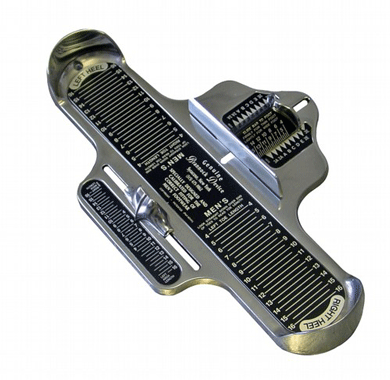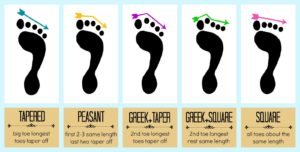Comfortable walking shoes: How to find shoes online that really fit.
When it comes to life’s simple pleasures, a good pair of comfortable walking shoes ranks right up there. There’s nothing like slipping on a new pair of shoes that really fit, and then walking for miles in cushy comfort.
Finding the perfect pair of walking shoes puts a spring in your step and a smile on your face.

On the other hand, ill-fitting shoes can cause blisters, bunions, corns, calluses, hammertoes, plantar fasciitis, stress fractures and more. So it’s important to get the fit dialed in before you step out the door.
Thankfully, ecommerce has made that much easier.
Now you can find a shoe that really fits without leaving the comfort of home.
You can now order multiple pairs online, test them all (inside the house) and send back the ones that don’t fit. Totally free of charge. So you can shop in the comfort of your own home, with no guesswork.
Fitting into a walking shoe is not the same as fitting into a tennis shoe or a cross-trainer. When you’re playing court sports or doing CrossFit you have a lot of lateral motion to contend with. Which means you need the shoe to be super snug, all the way around.
When you’re walking, the motion is one-directional. You don’t have to worry about the lateral motion you encounter in many other sports. In other words, you have a little more leeway in the fit. So they should be snug, but comfortable right away.

How to avoid buying shoes that are too big.
The problem is, many shoes that initially feel comfortable are simply too big for you. That’s the most common mistake people make when buying athletic shoes of any kind. That’s been my downfall over the years.
The common-sense solution is to crank down the laces and wear extra-thick socks, but that’s not so fun on a warm summer day. Better to find the right fit the first time.
Here’s the most thorough guide you’ll ever find on how to find shoes that really fit.

1. Have your feet measured. The metal gauge that measures the width and length of your feet is called a Brannock Device. Use it! The size and shape of your feet can change with time, so if it’s been more than a year, go to a store and have a good shoe salesman measure your feet. Then write it down.
Don’t just default to the size you have always worn, and don’t assume that both feet are the same size. Most people have one foot that is larger than the other, so make sure you have both feet measured. Fit your shoes to the larger foot. Also, It’s best to get measured at the end of the day when your feet are the largest. Don’t get measured right when you head out of the house in the morning.
2. Do the visual foot-shape test. I can tell with one quick glance whether a shoe’s going to come close to fitting me. Many brands are built on a last that simply won’t work because I have peasant’s feet – Square toes, not tapered. That’s is the simplest way to save time when buying walking shoes… Just look at the shape of the shoe; it should resemble the shape of your foot. Here are the basic foot shapes:

3. Do your research.
On this site, you can skim through an overview of walking shoes by brand. Learn what podiatrists say about certain shoes. Read the buyer’s guide to walking shoes, decide if you need aftermarket insoles and learn about specific foot conditions such as plantar fasciitis.
4. Order at least three pairs from Amazon. You can return the ones you don’t like, at no charge. Just like clothes, the size marked inside the shoe may be different depending on the brand. So your shoe size is just a starting point in selecting the correct shoe. Don’t assume that a size 9 in a New Balance walking shoe is the same as a size 9 Sketcher’s walking shoe.
5. Clip your toenails.
6. Stand in the shoes and walk around the house. First impressions can be misleading, so it’s best to leave each pair on for at least 20 minutes. (That’s what’s nice about shopping at home… you’re not pressured into a quick decision.)
7. Assess the fit, all the way around. Is there enough room at the balls of the feet? Do the heels fit snugly, or do they pinch or slip off? Don’t rationalize that the shoes just need to be “broken in.” Find shoes that fit from the start. Press gently on the top of the shoe to make sure you have 3/8 to a half-inch of space between your longest toe and the end of the shoe. This provides enough room for your foot to press forward as you walk. Wiggle your toes to make sure there’s enough room. Also, there should be some room in the back of the heel counter…slide an index finger behind your heel. If it doesn’t fit, go a size up; if it slides into the shoe easily, you should probably drop a half- to full-size. The ball of your foot (the widest part just before your toes begin) should fit comfortably in the widest part of the shoe. Stand on your tip-toes to ensure your toes can splay and are not hitting the front or top of the shoe. Gently kick a wall or use a decline ramp to ensure your toes will have enough room for walking downhill. There should be no hot spots or pinch points, with a snug, secure heel but ample room in the toes… you’ll know it when you feel it.
8. Trust your judgment and go for the Cinderella Moment. Your own gut instinct is more reliable than a shoe’s size, a review or description on a website. Sizes vary between manufacturers. And no matter how comfortable an advertisement claims those shoes are, you’re the real judge.
Feet come in many shapes and sizes. To avoid painful problems, consider the shape and size of your feet when buying a pair of walking shoes. Remember, your shoes should conform to the shape of your feet. Your feet should never be forced to conform to the shape of a pair of shoes.
What type of arches do you have?

The intricate alignment of bones, muscles, ligaments, and tendons in your feet forms side-to-side (metatarsal) and lengthwise (longitudinal) arches. As you walk, these springy, flexible arches help distribute your body weight evenly across your feet. Your arches play an important role in how you adapt to various surfaces as you walk.
Choose walking shoes that accommodate your arch type. Generally speaking, your feet fall into one of three categories:
- Neutral-arched feet. Your feet aren’t overly arched nor are they overly flat. Look for shoes with firm midsoles, straight to semi-curved lasts — last refers to the shape of the sole and the footprint around which the shoe is built — and moderate rear-foot stability.
- Low-arched or flat feet. Low arches or flat feet may contribute to muscle stress and joint problems in some individuals, though there is not a direct correlation. If you have significantly flat feet, you may benefit from a walking shoe with a straight last and motion control to help stabilize your feet.
- High-arched feet. High arches may contribute to excessive strain on joints and muscles, as your feet may not absorb shock as well, especially if you perform a lot of impact or jumping activities. Look for cushioning to compensate for your lack of natural shock absorption. A curved last also may help in some cases.
Not sure about your foot type? Dip your foot in water and step on a piece of cardboard. Examine your footprint. If you can see most of your footprint, you probably have low arches. If you see very little of your footprint, you likely have high arches. Most important of all, however, is comfort. Multiple studies have shown that there is no one “best shoe” for a particular foot type, and comfort and proper fit should be the main criteria you use.

